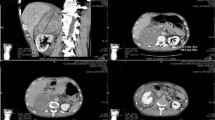Abstract
Objectives
Herein, we report a case of rupture of nonfunctional adrenal adenoma treated by nonsurgical supportive management due to high risk for operation.
Method and case
A patient with end stage renal disease (ESRD) who was on hemodialysis visited our emergency room and complained of a sudden abdominal pain after a fall. A retroperitoneal hemorrhage with hematoma formation around the adrenal adenoma, which was caused by rupture of the adrenal adenoma, was detected by abdominal computed tomography (CT).
Results
Supportive management was performed, with serial CT follow-up instead of surgical adrenalectomy treatment because of high operative risk, due to hemodialysis. After 1 week, the patient’s vital signs stabilized and the patient did not further complain about abdominal symptoms. However, supportive embolization was performed and the size of hematoma was more decreased.
Conclusion
We report a case of a patient on hemodialysis who experienced a rupture of a nonfunctioning adrenal adenoma, which was caused by low-energy trauma. The patient’s conditions improved with nonsurgical supportive management including embolization.
Learning point for clinicians
Physicians should consider both surgical and nonsurgical management for the rupture of adrenal adenomas, depending on the patient situation. Therefore, nonsurgical supportive management such as embolization can be one therapeutic option for treating nonfunctioning adrenal adenoma rupture caused by low-energy trauma in a patient who has risks for operation due to combined comorbidities.

Similar content being viewed by others
References
V.W. Ng, R.C. Ma, W.Y. So, K.C. Choi, A.P. Kong, C.S. Cockram, C.C. Chow, Evaluation of functional and malignant adrenal incidentalomas. Arch. Intern. Med. 170(22), 2017–2020 (2010)
I. Miyamori, Clinical aspect of adrenal incidentaloma. Nihon Rinsho 62(5), 925–928 (2004)
Y.S. Jee, Spontaneous ruptured pheochromocytoma: an unusual case report and literature review. Ann. Surg. Treat. Res. 93(3), 170–172 (2017)
J.O. Chung, D.H. Cho, J.H. Lee, D.D. Kwon, D.J. Chung, M.Y. Chung, Spontaneous rupture of a functioning adrenocortical carcinoma. Yonsei Med. J. 51(6), 974–977 (2010)
K. Suyama, T. Beppu, T. Isiko, S. Sugiyama, K. Matsumoto, K. Doi, T. Masuda, C. Ohara, H. Takamori, K. Kanemitsu, M. Hirota, H. Baba, Spontaneous rupture of adrenocortical carcinoma. Am. J. Surg. 194(1), 77–78 (2007)
G. Liguori, C. Trombetta, R. Knez, S. Bucci, R. Bussani, E. Belgrano, Spontaneous rupture of adrenal carcinoma during the puerperal period. J. Urol. 170(5), 1941 (2003)
Author information
Authors and Affiliations
Corresponding author
Ethics declarations
Conflict of interest
The authors declare that they have no conflict of interest.
Additional information
Publisher’s note: Springer Nature remains neutral with regard to jurisdictional claims in published maps and institutional affiliations.
Rights and permissions
About this article
Cite this article
Lee, K.A., Jin, H.Y. Non-surgically treated case of nonfunctioning ruptured adrenal adenoma in a patient on hemodialysis. Endocrine 65, 213–216 (2019). https://doi.org/10.1007/s12020-019-01948-3
Received:
Accepted:
Published:
Issue Date:
DOI: https://doi.org/10.1007/s12020-019-01948-3




